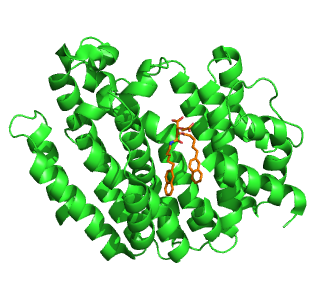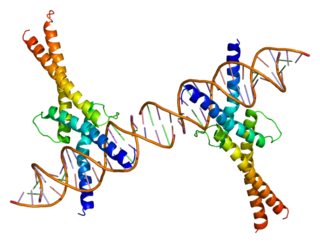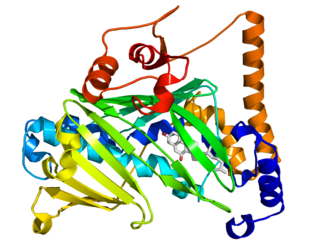Related Research Articles

Cholesterol is an organic molecule. It is a sterol, a type of lipid. Cholesterol is biosynthesized by all animal cells and is an essential structural component of animal cell membranes.

Paracrine signaling is a form of cell signaling or cell-to-cell communication in which a cell produces a signal to induce changes in nearby cells, altering the behaviour of those cells. Signaling molecules known as paracrine factors diffuse over a relatively short distance, as opposed to cell signaling by endocrine factors, hormones which travel considerably longer distances via the circulatory system; juxtacrine interactions; and autocrine signaling. Cells that produce paracrine factors secrete them into the immediate extracellular environment. Factors then travel to nearby cells in which the gradient of factor received determines the outcome. However, the exact distance that paracrine factors can travel is not certain.

HMG-CoA reductase is the rate-controlling enzyme of the mevalonate pathway, the metabolic pathway that produces cholesterol and other isoprenoids. Normally in mammalian cells this enzyme is suppressed by cholesterol derived from the internalization and degradation of low density lipoprotein (LDL) via the LDL receptor as well as oxidized species of cholesterol. Competitive inhibitors of the reductase induce the expression of LDL receptors in the liver, which in turn increases the catabolism of plasma LDL and lowers the plasma concentration of cholesterol, which is considered, by those who accept the standard lipid hypothesis, an important determinant of atherosclerosis. This enzyme is thus the target of the widely available cholesterol-lowering drugs known collectively as the statins.

Smith–Lemli–Opitz syndrome is an inborn error of cholesterol synthesis. It is an autosomal recessive, multiple malformation syndrome caused by a mutation in the enzyme 7-Dehydrocholesterol reductase encoded by the DHCR7 gene. It causes a broad spectrum of effects, ranging from mild intellectual disability and behavioural problems to lethal malformations.
Lipogenesis is the metabolic process through which acetyl-CoA is converted to triglyceride for storage in fat. The triglycerides in fat are packaged within cytoplasmic lipid droplets. The process begins with acetyl-CoA, which is an organic compound used to transfer energy from metabolism of carbohydrates, fatty acids, and ethanol. Through the citric acid cycle, acetyl-CoA is broken down to produce ATP, which is then an energy source for many metabolic processes, including protein synthesis and muscle contraction.

Sterol regulatory element-binding proteins (SREBPs) are transcription factors that bind to the sterol regulatory element DNA sequence TCACNCCAC. Mammalian SREBPs are encoded by the genes SREBF1 and SREBF2. SREBPs belong to the basic-helix-loop-helix leucine zipper class of transcription factors. Unactivated SREBPs are attached to the nuclear envelope and endoplasmic reticulum membranes. In cells with low levels of sterols, SREBPs are cleaved to a water-soluble N-terminal domain that is translocated to the nucleus. These activated SREBPs then bind to specific sterol regulatory element DNA sequences, thus upregulating the synthesis of enzymes involved in sterol biosynthesis. Sterols in turn inhibit the cleavage of SREBPs and therefore synthesis of additional sterols is reduced through a negative feed back loop.
The Hedgehog signaling pathway is a signaling pathway that transmits information to embryonic cells required for proper cell differentiation. Different parts of the embryo have different concentrations of hedgehog signaling proteins. The pathway also has roles in the adult. Diseases associated with the malfunction of this pathway include basal cell carcinoma.

Smoothened is a protein that in humans is encoded by the SMO gene. Smoothened is a Class Frizzled G protein-coupled receptor that is a component of the hedgehog signaling pathway and is conserved from flies to humans. It is the molecular target of the natural teratogen cyclopamine. It also is the target of Vismodegib, the first hedgehog pathway inhibitor to be approved by the U.S. Food and Drug Administration (FDA).

7-Dehydrocholesterol reductase, also known as DHCR7, is a protein that in humans is encoded by the DHCR7 gene.

Squalene synthase (SQS) or farnesyl-diphosphate:farnesyl-diphosphate farnesyl transferase is an enzyme localized to the membrane of the endoplasmic reticulum. SQS participates in the isoprenoid biosynthetic pathway, catalyzing a two-step reaction in which two identical molecules of farnesyl pyrophosphate (FPP) are converted into squalene, with the consumption of NADPH. Catalysis by SQS is the first committed step in sterol synthesis, since the squalene produced is converted exclusively into various sterols, such as cholesterol, via a complex, multi-step pathway. SQS belongs to squalene/phytoene synthase family of proteins.

Sterol regulatory element-binding protein cleavage-activating protein, also known as SREBP cleavage-activating protein or SCAP is a protein that in humans is encoded by the SCAP gene.

Niemann-Pick disease, type C1 (NPC1) is a disease of a membrane protein that mediates intracellular cholesterol trafficking in mammals. In humans the protein is encoded by the NPC1 gene.

Sterol regulatory element-binding transcription factor 1 (SREBF1) also known as sterol regulatory element-binding protein 1 (SREBP-1) is a protein that in humans is encoded by the SREBF1 gene.

Insulin induced gene 1, also known as INSIG1, is a protein which in humans is encoded by the INSIG1 gene.

The oxysterol-binding protein (OSBP)-related proteins (ORPs) are a family of lipid transfer proteins (LTPs). Concretely, they constitute a family of sterol and phosphoinositide binding and transfer proteins in eukaryotes that are conserved from yeast to humans. They are lipid-binding proteins implicated in many cellular processes related with oxysterol, including signaling, vesicular trafficking, lipid metabolism, and nonvesicular sterol transport.

Oxysterol-binding protein 1 is a protein that in humans is encoded by the OSBP gene.

Insulin induced gene 2, also known as INSIG2, is a protein which in humans is encoded by the INSIG2 gene.
Patched (Ptc) is a conserved 12-pass transmembrane protein receptor that plays an obligate negative regulatory role in the Hedgehog signaling pathway in insects and vertebrates. Patched is an essential gene in embryogenesis for proper segmentation in the fly embryo, mutations in which may be embryonic lethal. Patched functions as the receptor for the Hedgehog protein and controls its spatial distribution, in part via endocytosis of bound Hedgehog protein, which is then targeted for lysosomal degradation.

StAR-related lipid transfer protein 4 (STARD4) is a soluble protein involved in cholesterol transport. It can transfer up to 7 sterol molecules per minute between artificial membranes.

The SNX8 is a sorting nexin protein involved in intracelullar molecular traffic from the early endosomes to the TGN. It is suggested that it acts as an adaptor protein in events related to immune response and cholesterol regulation, for example. As a protein of the SNXs family, the SNX8 is formed of 465 aminoacids and presents a BAR-domain and a PX-domain which are very relevant in relation to its functions. Furthermore, SNX8 study is motivated by its medical significance in relation to diseases such as Alzheimer's Disease, cancer, neurodevelopmental malformations and to its role in fighting against viral infections.
References
- ↑ "Sterol-sensing domain". InterPro . European Bioinformatics Institute . Retrieved 25 March 2015.
- ↑ Kuwabara, PE; Labouesse, M (April 2002). "The sterol-sensing domain: multiple families, a unique role?". Trends in Genetics. 18 (4): 193–201. doi:10.1016/s0168-9525(02)02640-9. PMID 11932020.
- ↑ Pasca di Magliano, M; Hebrok, M (December 2003). "Hedgehog signalling in cancer formation and maintenance". Nature Reviews. Cancer. 3 (12): 903–11. doi:10.1038/nrc1229. PMID 14737121. S2CID 34050826.